Related Research Articles

Omar Nelson Bradley was a senior officer of the United States Army during and after World War II, rising to the rank of General of the Army. Bradley was the first chairman of the Joint Chiefs of Staff and oversaw the U.S. military's policy-making in the Korean War.
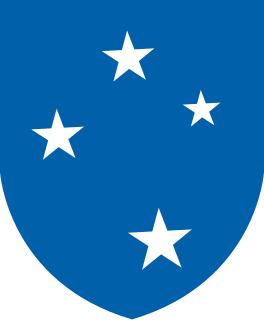
The 23rd Infantry Division, initially the Americal Division, of the United States Army was activated 27 May 1942 on the island of New Caledonia. In the immediate emergency following Pearl Harbor, the United States had hurriedly sent a task force to defend New Caledonia against a feared Japanese attack. This division was the only division formed outside of United States territory during World War II. At the suggestion of a subordinate, the division's commander, Major General Alexander Patch, requested that the new unit be known as the Americal Division—the name being a contraction of "American, New Caledonian Division". This was unusual, as with the exception of the Philippine Division, all other U.S. divisions were known by a number. After World War II the Americal Division was officially re-designated as the 23rd Infantry Division. However, it was rarely referred to as such, even on official orders.

The Combined Chiefs of Staff (CCS) was the supreme military staff for the United States and Britain during World War II. It set all the major policy decisions for the two nations, subject to the approvals of British Prime Minister Winston Churchill and U.S. President Franklin D. Roosevelt.

Charles Woodruff Yost was a career U.S. Ambassador who was assigned as his country's representative to the United Nations from 1969 to 1971.

The 92nd Infantry Division was an African-American infantry division of the United States Army that served in both World War I and World War II. The military was then segregated. The division was organized in October 1917, after the U.S. entry into World War I, at Camp Funston, Kansas, with African-American soldiers from all states. In 1918, before leaving for France, the American buffalo was selected as the divisional insignia due to the "Buffalo Soldiers" nickname, given to African-American cavalrymen in the 19th century. The divisional nickname, "Buffalo Soldiers Division", was inherited from the 366th Infantry, one of the first units organized in the division.
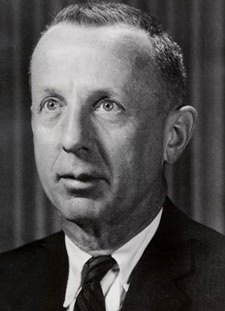
Charles Poor "Charlie" Kindleberger was an American economic historian and author of over 30 books. His 1978 book Manias, Panics, and Crashes, about speculative stock market bubbles, was reprinted in 2000 after the dot-com bubble. He is well known for his role in developing what would become hegemonic stability theory, arguing that a hegemonic power was needed to maintain a stable international monetary system. He has been referred to as "the master of the genre" on financial crisis by The Economist.

Pacific Ocean Areas was a major Allied military command in the Pacific Ocean theater of World War II. It was one of four major Allied commands during the Pacific War, and one of three United States commands in the Asiatic-Pacific Theater. Admiral Chester W. Nimitz of the U.S. Navy, Commander in Chief, U.S. Pacific Fleet, headed the command throughout its existence.
The Advisory Committee on Postwar Foreign Policy was a secretive committee created on February 12, 1942, to prepare recommendations for President Franklin D. Roosevelt on post World War II foreign policy. Predecessors included the similar Advisory Committee on Problems of Foreign Relations and the Division of Special Research. It was created by Secretary of State Cordell Hull at the suggestion of his assistant Leo Pasvolsky and Norman Davis of the Council on Foreign Relations. The committee appointed subcommittees on political problems, economic reconstruction, territorial matters, legal questions and the creation of an international organization, all under the direction of Pasvolsky. After four sessions, the main committee disbanded, Hull preferring to rely on the smaller subcommittees.
The Commonwealth of the Philippines was attacked by the Empire of Japan on 8 December 1941, nine hours after the attack on Pearl Harbor. Although it was governed by a semi-independent commonwealth government, the United States of America controlled the Philippines at the time and possessed important military bases there. The combined American-Filipino army was defeated in the Battle of Bataan and the Battle of Corregidor in April 1942, but guerrilla resistance against the Japanese continued throughout the war. Uncaptured Filipino army units, a communist insurgency, and supporting American agents all played a role in the resistance. Due to the huge number of islands, the Japanese never occupied many of the smaller and more minor islands. Japanese control over the countryside and smaller towns was often tenuous at best.

The military history of African Americans spans from the arrival of the first enslaved Africans during the colonial history of the United States to the present day. In every war fought by or within the United States, African Americans participated, including the Revolutionary War, the War of 1812, the Mexican–American War, the Civil War, the Spanish–American War, World War I, World War II, the Korean War, the Vietnam War, the Gulf War, the War in Afghanistan, and the Iraq War.

Frederick Carlton Weyand was a general in the United States Army. Weyand was the last commander of United States military operations in the Vietnam War from 1972 to 1973, and served as the 28th Chief of Staff of the United States Army from 1974 to 1976.

The Japanese occupation of the Philippines occurred between 1942 and 1945, when Imperial Japan occupied the Commonwealth of the Philippines during World War II.
The Advisory Committee on Problems of Foreign Relations was a committee created by United States Secretary of State Cordell Hull on December 27, 1939, to examine "overseas war measures." It came about after Leo Pasvolsky, Hull's assistant, wrote a memorandum urging such a committee concerned with "problems of peace and reconstruction" that would review fundamental principles of a "desirable world order" and was originally called the Committee on Problems of Peace and Reconstruction. It was one of many such committees that Hull would create, reorganize, rename or abolish. Successors included the Division of Special Research and the Advisory Committee on Postwar Foreign Policy.
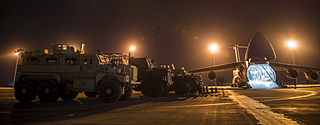
The 385th Air Expeditionary Group is a provisional United States Air Force unit assigned to Air Mobility Command to activate or inactivate as needed. It was last known to be stationed at Incirlik AB, Turkey. It is currently a tenant unit of the 379th Air Expeditionary Wing at Al Udeid Air Base, Qatar.
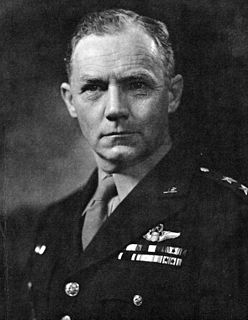
Donald Wilson was a United States Army Air Forces general during World War II.

The United States Army Air Forces was the major land-based aerial warfare service component of the United States Army and de facto aerial warfare service branch of the United States during and immediately after World War II (1941–1945). It was created on 20 June 1941 as successor to the previous United States Army Air Corps and is the direct predecessor of the United States Air Force, today one of the six armed forces of the United States. The AAF was a component of the United States Army, which on 2 March 1942 was divided functionally by executive order into three autonomous forces: the Army Ground Forces, the United States Army Services of Supply, and the Army Air Forces. Each of these forces had a commanding general who reported directly to the Army Chief of Staff.
Asian Americans, who are Americans of Asian descent, have fought and served on behalf of the United States since the War of 1812. During the American Civil War Asian Americans fought for both the Union and the Confederacy. Afterwards Asian Americans served primarily in the U.S. Navy until the Philippine–American War.
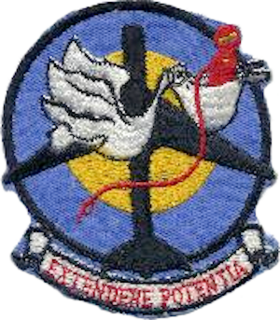
The 308th Air Refueling Squadron is an inactive United States Air Force unit. It was last assigned to the 2d Bombardment Wing at Hunter AFB, Georgia. It was inactivated on 1 March 1960.

Leo Pasvolsky was a journalist, economist, state department official and special assistant to Secretary of State Cordell Hull. He was one of the United States government's main planners for the post World War II world and "probably the foremost author of the UN Charter." Thomas Connally said in his memoirs "Certainly he had more to do with writing the framework of the charter than anyone else." His New York Times obituary is subtitled "Wrote Charter of World Organization." A short, rotund, mustachioed pipe smoker with a very large and round head, he joked that he might find it easier to roll than to walk. An aide compared him to the third little pig in the Three Little Pigs, Hull called him "Friar Tuck". A hardworking "one-man think tank" for Hull, he preferred to stay invisible, in the background. In the words of Richard Holbrooke, he "was one of those figures peculiar to Washington – a tenacious bureaucrat who, fixed on a single goal, left behind a huge legacy while virtually disappearing from history."

The 361st Tactical Missile Squadron is an inactive United States Air Force unit. It was formed in 1985 by the consolidation of the 1st Antisubmarine Squadron and the 661st Bombardment Squadron. However, the squadron was ever active under its new title.
References
- 1 2 Hilderbrand, Robert C. (2001). Dumbarton Oaks: The Origins of the United Nations and the Search for Postwar Security. Chapel Hill: University of North Carolina Press. p. 10. ISBN 0-8078-4950-2.
- ↑ "General Records of the Department of State - Part II: Records of Organizational Units" (PDF). Archived from the original (PDF) on 2010-06-22. Retrieved 2017-08-26.
- ↑ Rutherford, Malcolm (1998-04-21). The Economic Mind in America: Essays in the History of American Economics. ISBN 978-0-415-13355-5 . Retrieved 2008-03-21.